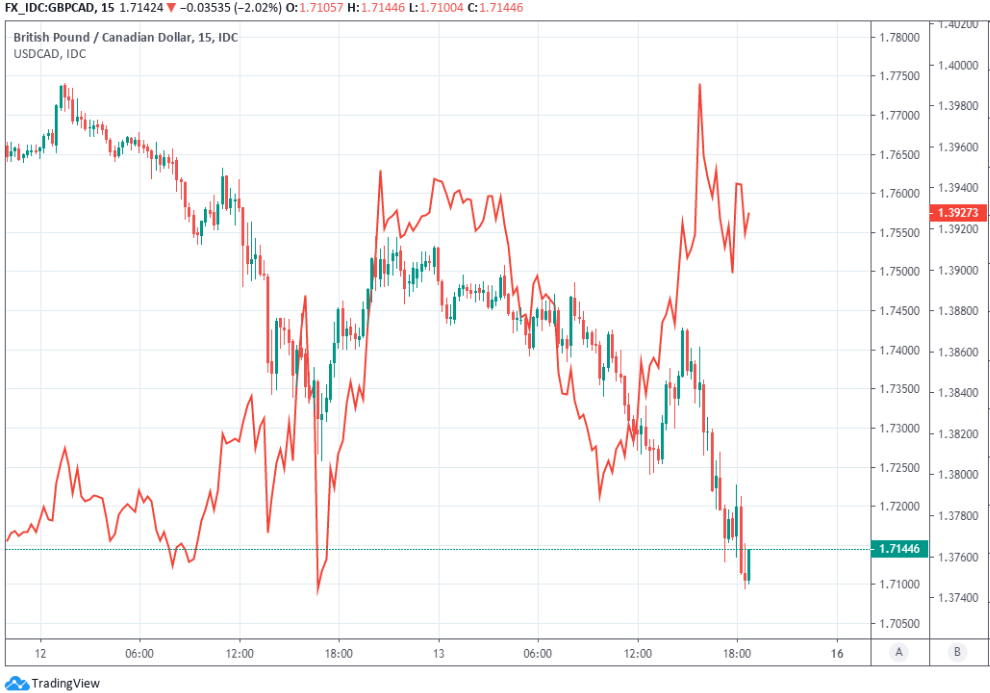Canadian Dollar Takes Second Surprise Bank of Canada Rate Cut On Chin
- Written by: James Skinner
-

Image © Bank of Canada, Reproduced Under CC Licensing
- GBP/CAD Spot rate: 1.7040, -2.7% on publication
- Indicative bank rates for transfers: 1.6450-1.6570
- Transfer specialist indicative rates: 1.6791-1.6894 >> Get your quote now
The Canadian Dollar advanced on the Pound and U.S. Dollar Friday in a curious reaction to the Bank of Canada (BoC) suprising markets with a second large interest rate cut in as many weeks.
The BoC said in a surprise announcement late Friday that it has decided to cut the cash rate by a further 50 basis points, taking it down to 0.75% following a disasterous week for oil prices, the country's largest export, and households who saw Prime Minister Justin Trudeau enter into self-isolation this week after it was confirmed that his wife has tested positive for the coronavirus that's threatening unprecedented damage to the global economy.
"This unscheduled rate decision is a proactive measure taken in light of the negative shocks to Canada’s economy arising from the COVID-19 pandemic and the recent sharp drop in oil prices. It is clear that the spread of the coronavirus is having serious consequences for Canadian families, and for Canada’s economy. In addition, lower prices for oil, even since our last scheduled rate decision on March 4, will weigh heavily on the economy, particularly in energy intensive regions," - Bank of Canada.
The Pound-to-Canadian Dollar rate continued its descent following the cut and USD/CAD fell further back from recent highs in what was a curious reaction from the Loonie, given that currencies normally have a severe aversion to rate cuts and the BoC's cut has just further reduced what was once a handsome yield advantage for the Canadian Dollar over other currencies. The Loonie has weakened sharply against the U.S. Dollar this month.

Above: Pound-to-Canadian Dollar rate shown at 15-minute intervals alongside USD/CAD rate (red line).
The rationale was set out by Governor Stephen Poloz as he stood with Finance Minister Bill Morneau who later announced a C$10 bn "credit support package" to help companies and households as they grapple with the coronavirus.
"Markets have latched onto an emerging narrative of coordinated fiscal easing as a complement to monetary support," says Mazen Issa, a strategist at TD Securities in a Wednesday note to clients. "With this in mind, we think markets will reward currencies that show bold fiscal action."
The rate cut came after a fierce sell-off took oil prices back toward $30 per barrel and left them carrying a near-50% loss for 2020. It also followed the heaviest losses for stocks since the financial crisis, which left some indices on course for their worst week in history and may have contributed to a surge in the U.S. Dollar that lifted USD/CAD 3.78% for the week into Friday.
"For now the BoC presumably welcomes the depreciation in the currency as it will partly offset the short-term disinflationary impact from lower oil prices while also providing a marginal boost for Canada's export competitiveness if it persists. However, if the depreciation in the CAD accelerates we may see the Governor ease off on the pace of rate cuts," says TD's chief Canada strategist Andrew Kelvin, in a Friday. "The experience in early 2016 is instructive; USDCAD lurched higher from 1.33 to 1.45 over one month, and the Bank subsequently held rates unchanged despite markets pricing in 13 bps of easing for January and 34 bps for the rest of the year."
Morneau said "we will do whatever it takes to stabilise the economy, we have the best balance sheet in the G7," before saying that further measures would be announced by the government next week.
Above: Pound-to-Canadian Dollar rate shown at daily intervals alongside USD/CAD rate (red line).
Morneau went to great lengths to emphasise that Friday's decisions were a "coordinated" and "proactive" move, before suggesting the bank and government will continue to work in concert.
"While he didn’t quote a specific number or the size of the stimulus, he did say it would be commensurate with the scale of the challenge. Earlier today we suggested that such a package should be on the order of $20bn," says Royce Mendes, an economist at CIBC Capital Markets. "The economic effects of the coronavirus continue to pile up, and today’s announcements will help weather the storm, although it’s unlikely they’re enough to avoid a recession given the inherently unique challenges."
The BoC's decision came with Prime Minister Trudeau in self-isolation and local economists increasingly tipping recessions in Canada and beyond. Meanwhile, Brazialian President Jair Bolsonaro was reported to havecoronavirus on Friday and the White House was reported to have called an emergency meeting as a result. President Donald Trump is known to have had contact with people who’ve since been confirmed as infected.
"Canada will experience a technical recession in 2020, as economic activity contracts in the second and third quarters of the year. The slowdown will limit growth for all of 2020 to 0.2%, a sharp decline from growth of 1.6% last year. Forecasts for the U.S., Europe and the U.K. are also weaker," says Craig Wright, chief economist at Royal Bank of Canada. "We expect the impact of the coronavirus to fade after the end of the first half, though low oil prices will constrain Canada’s recovery for the rest of the year."
Above: USD/CAD rate and WTI crude oil futures price (red line) shown at daily intervals.
The Friday rate cut came after the World Health Organization (WHO) officially acknowledged that the coronavirus epicentre is now Europe, where the hotspot is Italy with Spain now closing the gap between the two. It also comes as increasing numbers of countries are shutting schools and universities and banning public gatherings in an effort to contain the spread, which risks overloading healthcare systems if not kept at bay. It preceded President Donald Trump declaring a national emergency over the matter.
"We look for the Bank of Canada to cut the overnight rate to 0.25% no later than the April meeting, following the Fed," says TD's Kelvin. "The supply shock in the oil market probably would have been enough by itself to push the BoC to 0.25%, but the rapid deterioration in financial markets and swift action by the Federal Reserve will accelerate the process."
The Canadian Dollar strengthened modestly in response to the BoC and finance minister's coordination but the announcement came at the tailend of a session where risk assets, and appetite for them, had recovered somewhat. This was after the Federal Reserve (Fed) stepped into Thursday's sell-off and succesfully caught the falling knife. And amid all of that, the U.S. and Canadian Dollars (and bonds) were faring best among the majors.
Above: U.S. Dollar Index shown at daily intervals alongside CA 2-year Gov yields, which trades 0.25% below new cash rate.
"We continue to see the Bank of Canada cutting rates another 50bps, taking the overnight rate down to 0.25%, the effective lower bound during the last recession. Additional fiscal stimulus over and above what’s announced next week might also be needed. With markets now pricing in a recession, the question is how deep it will be and how long it will last," says CIBC's Mendes.
Central banks and governments in the U.S. and Canada are swinging into action with increased efforts to coordinate support for companies and households that could see businesses and incomes disrupted by efforts to contain the virus. That's in contrast to the situation in Europe, where the response has been fragmented among countries and anything but coordinated between central banks and governments, with the UK an exception.
"We think markets may begin to reward currencies that deliver bold fiscal support. Here, we think the US will eventually be positioned to meet this condition once the contours of a fiscal package emerge," says TD's Issa. "High beta FX like AUD and CAD remain price takers in this narrative and hence, are subject to the whims of risk sentiment and a softening global growth outlook. Tactically, we think it is prudent to be defensively positioned in these currencies still until we get a better sense of viral mitigation."
